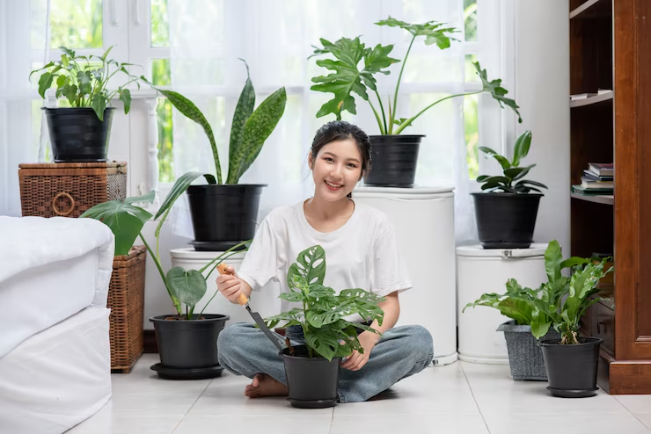You want to live a healthier life, but have you ever considered the impact of your indoor environment on your well-being? Indoor plants have become increasingly popular in recent years, and for good reason. Not only do they add aesthetic appeal to your home, but they also offer numerous health benefits.
Indoor plants have the power to purify the air, reduce stress, improve mood, and even boost productivity. By incorporating plants into your home, you can create a refreshing and relaxing environment that promotes a healthier lifestyle.
So, whether you’re a seasoned plant enthusiast or just starting out, read on to discover how indoor plants can transform your home and improve your overall well-being.

Purifying the Air with Indoor Plants
You can significantly improve the air quality in your living space by bringing in some green friends that work wonders in detoxifying the atmosphere. Indoor plants aren’t only aesthetically pleasing, but they also have the ability to purify the air by removing harmful toxins and pollutants.
Some of the best air-purifying plants include spider plants, peace lilies, and snake plants. These plants are easy to care for and can thrive in low-light conditions, making them perfect for any indoor space.
In addition to purifying the air, indoor plants offer a range of benefits for your overall health and well-being. Studies have shown that indoor gardening can reduce stress levels, improve mood, and boost productivity.
Plant care tips such as proper watering, fertilizing, and pruning can also help you develop a sense of responsibility and mindfulness. So why not bring some greenery into your home and reap the benefits of indoor gardening?
Not only will you be improving the air quality in your living space, but you’ll also be enhancing your lifestyle in a meaningful way.
Reducing Stress and Improving Mood
Feeling stressed and down? Adding some greenery to your space might just be the mood booster you need.
Indoor plants not only purify the air, but they also have a positive impact on your mental health. Nature therapy, also known as ecotherapy, is a form of treatment that involves spending time in nature to improve your overall well-being. By bringing nature indoors, you can experience the benefits of nature therapy without leaving your home.
In addition to nature therapy, indoor plants can also provide aromatherapy benefits. Certain plants, such as lavender and jasmine, have calming scents that can help reduce stress and anxiety. Aromatherapy has been used for centuries as a natural way to improve mood and promote relaxation.
By incorporating these plants into your home, you can create a calming and peaceful environment that promotes a healthier lifestyle. So, why not add some greenery to your space and experience the benefits for yourself? Read More!
Boosting Productivity with Greenery
By bringing a touch of nature into your workspace, you can cultivate a more productive and inspired atmosphere that’ll leave you feeling as fresh as a spring morning.
Greenery at work has been proven to boost productivity and creativity, reduce stress levels, and improve air quality. Plants have the ability to calm the mind and create a sense of relaxation, which can lead to better focus and concentration.
Plant-based motivation can also be a great tool for staying motivated and on-task. Having a plant on your desk or nearby can serve as a visual reminder of the natural world and can help to reduce mental fatigue.
Additionally, plants can help to improve air quality by absorbing harmful toxins and releasing oxygen into the air. By incorporating greenery into your workspace, you can create a healthier and more productive environment that’ll leave you feeling refreshed and energized.
Choosing the Right Plants for Your Home
Get ready to spruce up your space with the perfect greenery that will not only add a pop of color but also provide a breath of fresh air. Choosing the right plants for your home is important, as it can greatly affect the overall ambience and aesthetic of your living space.
One of the first things to consider is plant placement. Assess the lighting in your home and choose plants that thrive in the available light. For example, if your home has low light conditions, opt for plants such as snake plants or pothos. On the other hand, if your home receives ample sunlight, go for plants like succulents or cacti.
Another important factor to consider is maintenance tips. Different plants have different needs when it comes to watering, fertilizing, and pruning. Make sure to do your research on the plants you choose and set up a consistent schedule for care.
Additionally, matching plants with home decor can be a fun way to add personality to your living space. If your home has a bohemian vibe, go for plants with flowing leaves like ferns or spider plants. For a more minimalist look, choose plants with structured shapes like fiddle leaf figs or rubber trees.
By carefully selecting and caring for your indoor plants, you can create a healthier and more vibrant home environment.
Creating a Relaxing and Refreshing Environment
Who needs a relaxing and refreshing environment anyway? Definitely not me, said no one ever. We all crave a peaceful and calming space to unwind after a long day. And what better way to achieve that than by incorporating plants into your decor?
The benefits of greenery in interior design go beyond aesthetics – they’ve been proven to enhance our well-being and mood. Plants have a natural ability to purify the air by removing toxins and releasing oxygen. This not only improves air quality but also boosts our immune system, reduces stress and fatigue, and promotes better sleep.
In addition, plants have a calming effect on our senses, whether it’s the scent of fresh herbs or the sight of lush foliage. By bringing nature into our homes, we create a connection with the outdoors and a sense of tranquility that’s hard to replicate with artificial decor.
So why not invest in a few potted plants and create your own oasis of calm?
Frequently Asked Questions
How often should indoor plants be watered?
When it comes to watering your indoor plants, the frequency largely depends on the type of plant and its individual needs. However, as a general rule of thumb, it’s best to check the soil moisture level before watering.
Stick your finger about an inch into the soil – if it feels dry, it’s time to water. Overwatering can be just as detrimental as underwatering, so it’s important to find a balance.
Most indoor plants benefit from being watered once a week, but again, it’s important to check the soil moisture level and adjust accordingly. Remember to use room temperature water and avoid getting water on the leaves to prevent fungal growth.
With a little attention and care, your indoor plants will thrive and add beauty and life to your home.
What are some low-maintenance indoor plants for beginners?
Looking to add some greenery to your living space but don’t have a lot of time or space to spare? Fortunately, there are plenty of low-maintenance indoor plants that are perfect for beginners.
Some of the best indoor plant species for small spaces include succulents, snake plants, and pothos plants. These plants are easy to care for and can thrive in a variety of lighting and temperature conditions.
When it comes to decorating with indoor plants, there are a few tips to keep in mind. First, choose plants that complement your existing decor and add a touch of natural beauty to your space. Second, make sure to give your plants enough space to grow and thrive.
Finally, don’t be afraid to experiment with different types of plants and arrangements until you find the perfect fit for your home.
Can indoor plants help with allergies and respiratory issues?
Are you tired of constantly sneezing and coughing due to allergies or respiratory issues?
Indoor plants may just be the solution you need. Not only do they add a touch of greenery to your home, but they can also improve air quality by removing harmful toxins and pollutants.
Studies have shown that indoor gardening can have numerous benefits for mental health as well, such as reducing stress and improving mood.
Incorporating a few low-maintenance indoor plants into your living space can make all the difference in creating a healthy and happy environment.
So why not give it a try and see the positive impact it can have on your well-being?
How do I prevent pests from infesting my indoor plants?
Are you tired of dealing with pesky pests infesting your indoor plants? Luckily, there are natural pest control methods you can try before resorting to harsh chemicals.
DIY remedies such as neem oil, garlic spray, and insecticidal soap can be effective in keeping pests at bay. Neem oil, derived from the neem tree, is a natural insecticide that can be mixed with water and sprayed onto plants.
Garlic spray, made by blending garlic cloves with water and straining the mixture, can repel pests with its strong odor. Insecticidal soap, made from a mixture of water and soap, can suffocate and kill pests on contact.
By using these natural pest control methods, you can keep your indoor plants healthy and thriving without harming the environment.
Are there any indoor plants that are toxic to pets?
If you’re a pet owner and looking to add some greenery to your home, it’s important to be aware of the common indoor plants that are toxic to pets. Some of the most popular plants that are toxic to both cats and dogs include the peace lily, snake plant, and pothos.
However, there are also many pet-friendly alternatives, such as spider plants, Boston ferns, and bamboo palm. Not only do these plants provide a beautiful aesthetic to your home, but they also offer numerous benefits for your mental health, such as reducing stress and increasing productivity.
So, before adding any indoor plants to your home, make sure to do your research and opt for pet-friendly options to keep both your furry friends and your home happy and healthy.
Conclusion
In conclusion, incorporating indoor plants into your living space can have a profound impact on your health and well-being. These green beauties not only purify the air, but also reduce stress, improve mood, and boost productivity.
Picture yourself walking into your home after a long day at work. As you step inside, you’re greeted by a lush, vibrant fern nestled in a corner. The sight of its green leaves instantly calms your nerves and lifts your spirits. You take a deep breath and inhale the fresh, clean air, feeling a renewed sense of energy and vitality.
With so many benefits to offer, it’s easy to see why indoor plants have become a popular trend in home decor. So why not join in on the fun and transform your living space into a sanctuary of health and happiness? By choosing the right plants for your home and creating a relaxing, refreshing environment, you’ll soon find yourself reaping the rewards of a healthier lifestyle.

